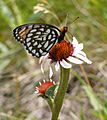Waubay Wetland Management District facts for kids
The Waubay Wetland Management District is a special natural area in South Dakota. It's found in a beautiful region called the "Coteau des Prairies". This name means "prairie hills" in French.
This district is home to over 300 important places called waterfowl production areas, or WPAs for short. These WPAs are spread across six counties in northeastern South Dakota. The counties are Clark, Codington, Day, Grant, Marshall, and Roberts.
Each WPA can be different in size. They range from about 40 acres (16 ha) to more than 1,600 acres (650 ha). Together, all these areas cover a huge space of about 40,000 acres (160 km2). WPAs are super important because they provide a safe home for many wild animals. This is especially true in areas where there are lots of farms and pastures.
What are Waterfowl Production Areas?
Waterfowl Production Areas (WPAs) are like special nature parks. They are managed to protect wetlands and grasslands. These habitats are vital for many types of birds, especially waterfowl like ducks and geese. They also help other wildlife, from small insects to larger mammals.
Exploring the District
You can visit all the WPAs, but you can only explore them on foot. This means you'll need to walk! Many of the bigger WPAs have grassy parking spots. These are great for leaving your car safely off the main road.
There are no buildings or special hiking trails in the WPAs. This helps keep the areas wild and natural. While these places are very popular during hunting seasons, they are also wonderful to visit at other times of the year. You can enjoy the peace and quiet and discover the amazing nature of South Dakota.
A Bit of History
The Waubay Wetland Management District has a cool history. It includes the very first waterfowl production area ever created! This special place is called McCarlson WPA. It was bought in January 1959 from Arnold and Lydia McCarlson. This was a big step in protecting wetlands for wildlife.
Gallery
-
A regal fritillary butterfly (Speyeria idalia) sips nectar from a purple coneflower (Echinacea angustifolia).
-
A beautiful pink wild onion (Allium stellatum) blooming in the tallgrass prairie.





